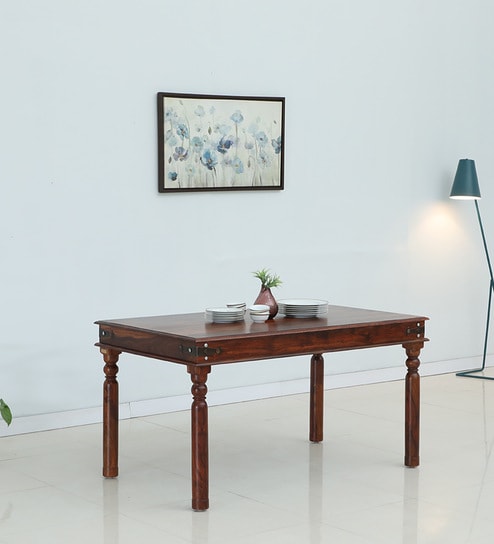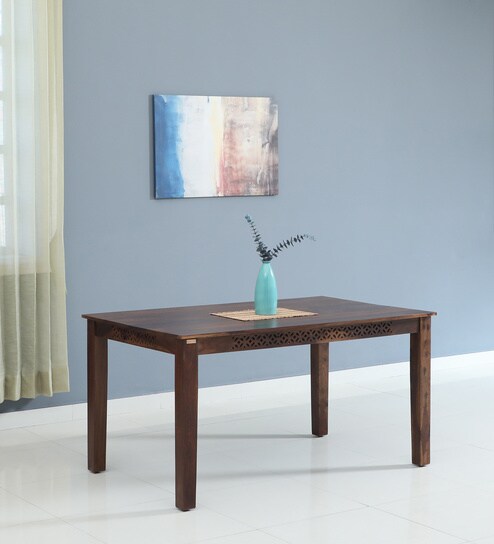Traditional 6 Seater Dining Tables
Filter By More Filters
More Filters
Sort By
Showing 1-14 of 14 options inTraditional 6 Seater Dining Tables
0false
1false
2false
3false
4false
5false
6false
7false
8false
9false
10false
11false
12false
13false
Didn't Find What You Were Looking For? Share your Feedback with Us ->
Traditional 6 Seater Dining Tables: A Comprehensive Guide
In the ever-evolving landscape of interior design, traditional 6-seater dining tables stand as a steadfast symbol of timeless allure. Their enduring popularity is rooted in their classic design, adaptability, and the warm, inviting ambiance they bring to any dining area. In this informative article, we delve into the various aspects of traditional 6-seater dining tables, offering insights into their design, advantages, and considerations, allowing you to make a well-informed choice when selecting the ideal centerpiece for your dining space.
The Appeal of Traditional Design
Traditional 6-seater dining tables are characterized by their enduring and often embellished design features. Drawing inspiration from historical design styles like Victorian, Colonial, or European influences, these tables boast the following defining attributes:
Elegance: Traditional dining tables emanate an air of sophistication and refinement. Elaborate detailing on the legs and apron, frequently accompanied by opulent wood finishes, create an inviting and luxurious atmosphere in your dining area.
Solid Wood Construction: Crafted from premium wood types such as oak, mahogany, or cherry, traditional dining tables are renowned for their resilience. The use of solid wood guarantees that these tables can withstand the test of time, retaining their splendor even after years of use.
Intricate Carvings: Elaborate carvings on the table legs and edges are a common hallmark of traditional designs. These intricate details add depth and character to the table, making it a focal point in your dining room.
Timeless Hues: Traditional tables typically feature rich, warm wood tones such as dark brown, cherry, or walnut. These colors foster a cozy and inviting ambiance, ensuring your dining space exudes comfort.
Adaptive Seating Arrangements
One of the primary benefits of traditional 6-seater dining tables lies in their adaptability when it comes to seating arrangements. Here's how these tables can accommodate various dining needs:
Family Gatherings: The standard 6-seater table size is ideal for family dinners, comfortably accommodating parents and children. This makes it a suitable choice for everyday meals and special family occasions.
Entertaining Guests: Traditional dining tables can be extended using leaves or extensions, allowing you to host larger gatherings without the need for an additional table. Simply add more chairs, and you're ready to entertain.
Intimate Dining: If you seek a cozy setup for romantic dinners, a 6-seater table can also be used with just two chairs, creating an intimate atmosphere and freeing up space in your dining room.
Diverse Seating Options: Traditional dining chairs designed for these tables often feature cushioned seats and upholstered backs, ensuring comfort during lengthy meals. You can also mix and match various chair styles for a personalized touch.
The Timelessness of Traditional 6 Seater Dining Tables
In a world where design trends frequently shift, traditional 6-seater dining tables remain a steadfast choice for numerous homeowners. Here's why they stand the test of time:
Classic Allure: The enduring design of traditional dining tables ensures they never fall out of favor. They seamlessly blend with a wide range of interior aesthetics, from vintage to contemporary.
Superior Craftsmanship: Traditional tables are often meticulously handcrafted by skilled artisans, guaranteeing impeccable quality and meticulous attention to detail. This craftsmanship results in furniture that stands the test of time.
Emotional Significance: Many families hold cherished memories linked to their traditional dining tables, forming an emotional connection that transcends fleeting trends.
Long-term Investment: While traditional dining tables may carry a higher initial cost, they represent an investment in lasting durability and style. Their value appreciates over time, making them a prudent choice for homeowners.
Tips for Selecting the Ideal Traditional 6-Seater Dining Table
When choosing a traditional dining table for your home, consider these key factors:
Room Dimensions: Measure your dining area to ensure the table fits comfortably, leaving ample space for chairs and maneuvering. Allow for at least 36 inches of clearance around the table for easy access.
Seating Requirements: Assess your typical dining needs. If you frequently host guests, consider a table with extension leaves. For an intimate setting, a smaller, round table may be more suitable.
Material and Finish: Opt for a wood type and finish that complements your existing decor. Darker woods like mahogany create a more formal ambiance, while lighter woods like oak impart a casual feel.
Design Elements: Pay attention to design elements such as carvings, legs, and table shape to ensure they align with your personal style and the overall aesthetic of your dining space.
Comfortable Seating: Select dining chairs that not only look appealing but also offer comfort during extended meals. Chairs with cushioned seats and backrests contribute to enhanced comfort.
Traditional 6-seater dining tables continue to captivate homeowners as a symbol of enduring elegance and unwavering quality in the realm of interior design. Their timeless allure, adaptability, and capacity to cater to diverse dining requirements make them a valuable addition to any residence. By comprehending the charm and merits of traditional dining tables, you can make a well-informed decision when choosing the ideal focal point for your dining room. Investing in a traditional dining table means creating a welcoming and stylish space that will be cherished for generations to come.
Most Searched In Traditional 6 Seater Dining Tables
3 Seater Sofas 2 Seater Sofas 1 Seater Sofas 4 Seater Dining Sets 6 Seater Dining Sets 8 Seater Dining Sets 2 Seater Dining Sets Sectional Sofas LHS Sectional Sofas RHS Sectional Sofas Rocking Chairs Folding Chairs Iconic Chairs Cafe Chairs Bedside Tables Bar Furniture Bar Cabinets Bar Chairs Shoe Racks Shoe Cabinets Shoe Rack with Seating Wardrobes 1 Door Wardrobes 2 Door Wardrobes 3 Door Wardrobes 4 Door Wardrobes Sliding Door Wardrobes Beds Queen Size Beds King Size Beds Single Beds 2 Seater Dining Tables 4 Seater Dining Tables 6 Seater Dining Tables Side Tables Cabinets and Sideboards Chest of Drawers Pouffes Cribs Kids Beds Bunk Beds Kids Wardrobes Book Cases Centre Tables Coffee Tables Crockery Units Dressing Tables Dressers Dressing Cabinets Dressing Units Study Tables Computer Tables Foldable Study Tables Sofa Cum Beds Book Shelves Office Furniture Office Chairs Office Tables Gaming Chairs Sofa Chairs Wing Chairs Bean Bags Bean Bags with Beans Recliners TV Units Table and Chair Sets Plastic Chairs TV Consoles Tables 
















